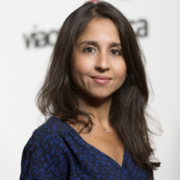We spoke to our key people in Europe, the Americas, MENA, and APAC to get their insights into the challenges faced by operators in their own regions and how business is shaping up for the year ahead.

It has been another hectic year in the global video industry with no sign of the accelerated pace of change we have all been living with slowing down. To pick just one example out of many, at the beginning of the year it was close to unthinkable that Netflix or Disney+ would ever launch advertising-funded services, and both have launched AVOD-powered tiers within the past month.
Because of the reach and the influence of the vast US market, the new technologies and consumer trends that first manifest there tend to dominate the conversation regarding the future development of the industry. But their impact around the world is, of course, not even. So, to build up a picture of what is going on at a global scale, we gathered our experts together in one room and asked them about the trends and the challenges in their own parts of the world. From the Americas through Europe and MENA and on to APAC, here’s what they said.
Taking part:
Arnaud Alvarez, EVP Global Sales
Sammer Elia, Business Development Director, MENA
Dokyung ‘DK’ Lee, VP Sales (APAC)
Carlos Ramos, VP Business Development Americas
- What are the main overall trends in your region?
DK: Country by country it’s quite different and depends on the operator’s existing networks and the prevailing infrastructure. In APAC, we have customers that are looking to secure and expand their IPTV services, customers that are looking to offer OTT alongside IPTV, and customers that are pushing only into OTT. It all depends on your starting point.
Sammer: There are three things that dominate any conversations we have in the MENA region: Monetisation via targeted advertising, the importance of anti-piracy efforts, and how to optimise workflows and ensure that the quality of experience for their customers remains excellent.
Arnaud: FAST services are growing quickly, not just in Europe but around the world. As a result, we are seeing more customers looking for end-to-end solutions where we supply the content.
Carlos: Super Aggregation is without doubt the main trend in the Latin-America region. Big data and effective use of data analytics as well.
2. When you talk to customers, what are their main aims for the next few years?
DK: More effective monetisation via the introduction of new services is something most of our customers are interested in. Targeted advertising is rapidly growing in popularity as is the move towards Super Aggregation. One interesting common feature is that everyone wants their systems to be open. Nobody wants to be locked into a single platform.
Sammer: It depends on who you talk to. But certainly, when we speak to telcos, they are very interested in shaping the customer journey within an optimized super-aggregation framework. For the streaming platforms, the effective management of user data (personalization, targeting, engagement, and so on) is of utmost priority.
Carlos: Everyone is talking about cloud multi-tenancy solutions, the importance of a content hub (Super Aggregation), reliability, and customization. AndroidTV STBs are being embraced in bulk as operators look to drop Linux STBs.
Arnaud: Our customers are looking for a single point of contact to oversee everything relating to their service. They want to eliminate complexity and as they look to implement things such as Super Aggregation, they want us to work as active partners supplying a genuinely end to end solution.
3. What are the challenges? How are they unique to the region?
DK: I think perhaps the challenges in APAC are the same as all over the world: operators face competition from the large global players and as a result they are constantly looking for ways they can differentiate themselves. Generating increasing amounts of local content is a key part of that.
Sammer: Competition is everywhere. At one point, Netflix, for example, was just a North American company, then it was a company that was in your own country but only where there was good broadband. Now, with mobile-first business models, it’s everywhere. What is unique to us in MENA? We have more than 350 million people that speak the same language within one of the richest and most diverse cultural landscapes. It is a massive opportunity for OTT players to monetize their services by adopting the right advertisement framework and marketplace, leveraging an affinity with the region to maximize inventory exposure and benefit from higher CPM offers.
Arnaud: Europe is a mature market which is still growing and starting to look ahead at its next generation services. The metaverse and its implications for broadcasters is starting to be discussed and there is also a lot of interest in gaming as a differentiator.
Carlos: Super Aggregation is a big challenge as it requires deep relationships with all networks and studios, universal search, embedded playback of content from third party OTT suppliers, and control of the data. It is also a major shift for many towards TV working 100% under apps using OTT technologies.
4. What is the current impact of piracy?
DK: In APAC it’s very serious and each year brings a new set of problems, such as encrypted links sharing through the Telegram app. Operators need to spend more money on effective third-party solutions such as ours, as their in-house teams are often struggling to keep up, but it’s not always easy to convince them to find the budget at C-level.
Sammer: Piracy is everywhere, and we need to educate people... but we also have the tools to fight it. We need to close the loop and extend the anti-piracy framework to the telcos and the regulators and the major vendors.
Arnaud: In Europe the impact is still high as pirates come up with new attack methods. The key to fighting that is to increase the adoption of robust, joined-up anti-piracy services and technologies such as watermarking. And as more people realise the sheer level of revenue they are losing to pirates, they will become more willing to invest in these services.
Carlos: In LATAM the impact of piracy is high as it hasn’t been seriously taken into consideration for long enough. Some big operators are starting to take measurements but unfortunately nothing too profound yet.
5. What are the buzzwords? What is making operators excited about where you are?
DK: In APAC it’s implementing addressable TV and advertising and unlocking the monetisation potential there. And, for sports in particular, genuinely low latency streaming.
Sammer: In MENA we’re moving into the age of OTT 2.0. Operators want data-driven insights provided by AI and Machine Learning, they want improved QoX with advanced UI functionalities and recommendations, and they want to be socially responsible. Many are looking to migrate social media back to being engagement channels instead of a main revenue source.
Carlos: Android TV is a big buzz in LATAM. So is Super Aggregation, Universal Search, and Content Hub.
Arnaud: Sustainability and green streaming is becoming increasingly important at both the consumer and the corporate level in many countries across the globe.
6. What is the outlook for 2023? If you were to rank your score for business optimism in the region, what would you give it out of 10?
DK: We’re actively involved with several tenders in APAC, so I’m going to say 7.5/10. There are challenges along the way, but it’s a growing market and our technology is a good fit for operators’ needs.
Sammer: At the end of the day, we’re talking about a MENA market which normally has a high level of investment, and this is being exacerbated as capital flees the consequences of the Russia/Ukraine war and interest in investing in the region is further boosted by high profile events such the International Expo in Dubai and the FIFA World Cup in Qatar. So, I would say 8/10.
Carlos: We have lots going on here in LATAM, now and well into the new year. It’s an exciting time. 8/10
Arnaud: If we look at 2023 as the first true post Covid year then I think globally we will start seeing the market freeing up more and more and companies starting to move forward with their plans once again. Inflation may play a part in damping things down, perhaps, but the streaming market is still growing strongly. 8/10.
